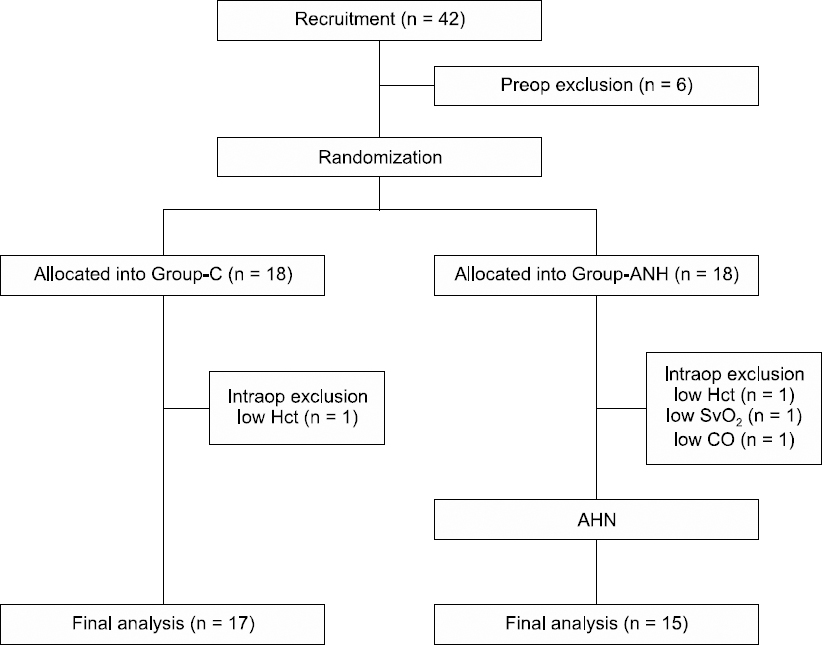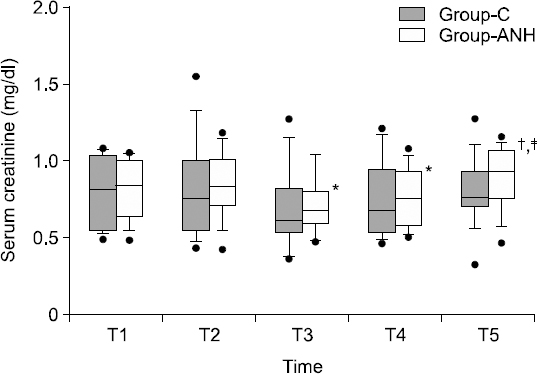1. Bennett SR. Perioperative autologous blood transfusion in elective total hip prosthesis operations. Ann R Coll Surg Engl. 1994; 76:95–8. DOI:
10.1097/00132586-199412000-00057.
2. Bennett J, Haynes S, Torella F, Grainger H, McCollum C. Acute normovolemic hemodilution in moderate blood loss surgery: a randomized controlled trial. Transfusion. 2006; 46:1097–103. DOI:
10.1111/j.1537-2995.2006.00857.x. PMID:
16836555.
3. Berg KS, Stenseth R, Wahba A, Pleym H, Videm V. How can we best predict acute kidney injury following cardiac surgery?: a prospective observational study. Eur J Anaesthesiol. 2013; 30:704–12. DOI:
10.1097/EJA.0b013e328365ae64. PMID:
24067536.
4. Mangano CM, Diamondstone LS, Ramsay JG, Aggarwal A, Herskowitz A, Mangano DT. Renal dysfunction after myocardial revascularization: risk factors, adverse outcomes, and hospital resource utilization. The Multicenter Study of Perioperative Ischemia Research Group. Ann Intern Med. 1998; 128:194–203. DOI:
10.7326/0003-4819-128-3-199802010-00005. PMID:
9454527.
5. Jung HS, Kim CS, Kim TY. The relationship of serum creatinine and cardiac troponin I after off-pump coronary artery bypass graft surgery. Anesth Pain Med. 2009; 4:124–8.
7. Akcan-Arikan A, Zappitelli M, Loftis LL, Washburn KK, Jefferson LS, Goldstein SL. Modified RIFLE criteria in critically ill children with acute kidney injury. Kidney Int. 2007; 71:1028–35. DOI:
10.1038/sj.ki.5002231. PMID:
17396113.
8. Bellomo R, Ronco C, Kellum JA, Mehta RL, Palevsky P. Acute renal failure - definition, outcome measures, animal models, fluid therapy and information technology needs: the Second International Consensus Conference of the Acute Dialysis Quality Initiative (ADQI) Group. Crit Care. 2004; 8:R204–12. DOI:
10.1186/cc2671. DOI:
10.1186/cc2872. PMID:
15312219. PMCID:
PMC522841.
9. Mehta RL, Kellum JA, Shah SV, Molitoris BA, Ronco C, Warnock DG, et al. Acute Kidney Injury Network: report of an initiative to improve outcomes in acute kidney injury. Crit Care. 2007; 11:R31. DOI:
10.1186/cc5713. PMID:
17331245. PMCID:
PMC2206446.
10. Parolari A, Pesce LL, Pacini D, Mazzanti V, Salis S, Sciacovelli C, et al. Risk factors for perioperative acute kidney injury after adult cardiac surgery: role of perioperative management. Ann Thorac Surg. 2012; 93:584–91. DOI:
10.1016/j.athoracsur.2011.09.073. PMID:
22269725.
11. Kumar AB, Suneja M, Bayman EO, Weide GD, Tarasi M. Association between postoperative acute kidney injury and duration of cardiopulmonary bypass: a meta-analysis. J Cardiothorac Vasc Anesth. 2012; 26:64–9. DOI:
10.1053/j.jvca.2011.07.007. PMID:
21924633.
12. Rosner MH, Okusa MD. Acute kidney injury associated with cardiac surgery. Clin J Am Soc Nephrol. 2006; 1:19–32. DOI:
10.2215/CJN.00240605. PMID:
17699187.
13. Bojan M, Lopez-Lopez V, Pouard P, Falissard B, Journois D. Limitations of early serum creatinine variations for the assessment of kidney injury in neonates and infants with cardiac surgery. PLoS One. 2013; 8:e79308. DOI:
10.1371/journal.pone.0079308. PMID:
24244476. PMCID:
PMC3823616.
14. Waikar SS, Liu KD, Chertow GM. Diagnosis, epidemiology and outcomes of acute kidney injury. Clin J Am Soc Nephrol. 2008; 3:844–61. DOI:
10.2215/CJN.05191107. PMID:
18337550.
15. Lassnigg A, Schmid ER, Hiesmayr M, Falk C, Druml W, Bauer P, et al. Impact of minimal increases in serum creatinine on outcome in patients after cardiothoracic surgery: do we have to revise current definitions of acute renal failure? Crit Care Med. 2008; 36:1129–37. DOI:
10.1097/CCM.0b013e318169181a. PMID:
18379238.
16. Lassnigg A, Schmidlin D, Mouhieddine M, Bachmann LM, Druml W, Bauer P, et al. Minimal changes of serum creatinine predict prognosis in patients after cardiothoracic surgery: a prospective cohort study. J Am Soc Nephrol. 2004; 15:1597–605. DOI:
10.1097/01.ASN.0000130340.93930.DD. PMID:
15153571.
17. Chertow GM, Burdick E, Honour M, Bonventre JV, Bates DW. Acute kidney injury, mortality, length of stay, and costs in hospitalized patients. J Am Soc Nephrol. 2005; 16:3365–70. DOI:
10.1681/ASN.2004090740. PMID:
16177006.
18. Swaminathan M, Phillips-Bute BG, Conlon PJ, Smith PK, Newman MF, Stafford-Smith M. The association of lowest hematocrit during cardiopulmonary bypass with acute renal injury after coronary artery bypass surgery. Ann Thorac Surg. 2003; 76:784–91. DOI:
10.1016/S0003-4975(03)00558-7.
20. Cockcroft DW, Gault MH. Prediction of creatinine clearance from serum creatinine. Nephron. 1976; 16:31–41. DOI:
10.1159/000180580.
21. Edwards KD, Whyte HM. Plasma creatinine level and creatinine clearance as tests of renal function. Australas Ann Med. 1959; 8:218–24. PMID:
13819423.
22. Stafford-Smith M. Perioperative renal dysfunction: Implications and strategies for protection. Perioperative Organ Protection. Newman MF, editor. Richmond, Society of Cardiovascular Anesthesiologists. 2003; 89–124.






 PDF
PDF Citation
Citation Print
Print


 XML Download
XML Download